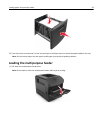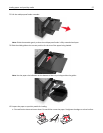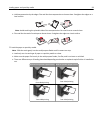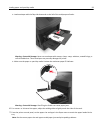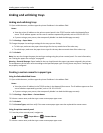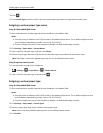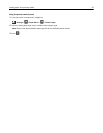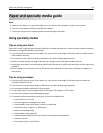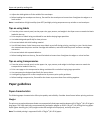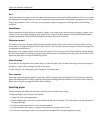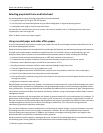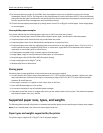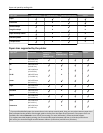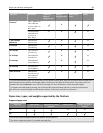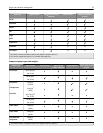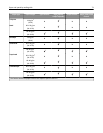
• Adjust the width guides to fit the width of the envelopes.
• Before loading the envelopes on the tray, flex and fan the envelopes to loosen them. Straighten the edges on a
level surface.
Note: A combination of high humidity (over 60%) and high printing temperature may wrinkle or seal envelopes.
Tips on using labels
• From the printer control panel, set the paper size, type, texture, and weight in the Paper menu to match the labels
loaded in the tray.
• Print samples on labels being considered for use before buying large quantities.
• Use labels designed specifically for laser printers.
• Do not use labels with slick backing material.
• Use full label sheets. Partial sheets may cause labels to peel off during printing, resulting in a jam. Partial sheets
also contaminate the printer and the cartridge with adhesive, and could void the printer and toner cartridge
warranties.
• Do not use labels with exposed adhesive.
• Before loading labels on the tray, flex and fan labels to loosen them. Straighten the edges on a level surface.
Tips on using transparencies
• From the printer control panel, set the paper size, type, texture, and weight in the Paper menu to match the
transparencies loaded in the tray.
• Print a test page on the transparencies being considered for use before buying large quantities.
• Use transparencies designed specifically for laser printers.
• Avoid getting fingerprints on the transparencies to prevent print quality problems.
• Before loading transparencies, flex and fan the sheets to prevent them from sticking together.
Paper guidelines
Paper characteristics
The following paper characteristics affect print quality and reliability. Consider these factors before printing on them:
Weight
The printer trays and multipurpose feeder can automatically feed paper weights between 60–176 g/m
2
(16–47‑lb) grain
long paper. The 2100‑sheet tray can automatically feed paper weights up to 60–135 g/m
2
(16–36‑lb) grain long paper.
Paper lighter than 60 g/m
2
(16 lb) might not be stiff enough to feed properly, and may cause jams.
Note: Two‑sided printing is supported for 60–176 g/m
2
(16–47‑lb) paper.
Paper and specialty media guide 64



